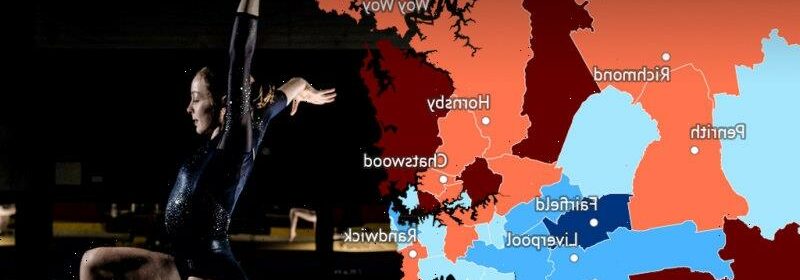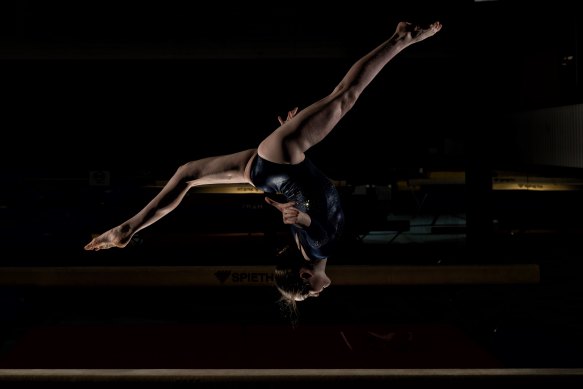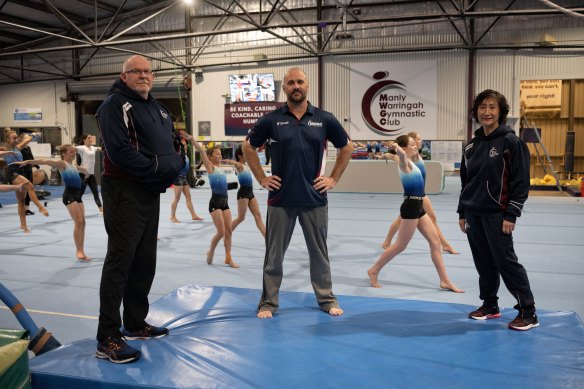Why some Sydney suburbs aren’t using free sports vouchers

With a balance beam in the living room, a tumble track in the carport and a chin-up bar in the bathroom, Chloe Muntz wasn’t worried about losing her fundamental gymnastics skills when Sydney went into lockdowns in 2020 and 2021.
But the 14-year-old from Killara – who hopes to represent Australia one day – was worried about losing the elite-level skills she had been learning at Manly Warringah Gymnastics Club.
Chloe Muntz, who trains at Manly Warringah Gymnastics Club, hopes to represent Australia one day.Credit:Nick Moir
“I mainly worried that I would lose the new skills that I had been working on”.
Now, sporting bodies are trying to encourage athletes such as Chloe back and ensure their skills aren’t lost.
Some received a significant boost from the NSW government’s Active Kids vouchers, which gives parents and carers two $100 vouchers per child for sport and active recreation costs.
Manly Warringah Gymnastics Club CEO Ian Hardy worried that young women and girls would have lost crucial years of training and competition to COVID, but the vouchers have helped lead the club’s resurgence.
“We have athletes who are trying to qualify for World Games or Commonwealth Games and Paris 2024, but they haven’t had the opportunity to compete at the highest level for two years,” Hardy said. “We have the Active Kids vouchers, and we go through a lot of them.”
The Northern Beaches Council area has one of the highest uptakes in NSW, with 72 per cent of eligible children between four and a half and 18 accessing the vouchers.
But there is inequality when it comes to who is benefiting the most from the vouchers.
In the Camden LGA, the vouchers have an 80 per cent uptake, but that drops to 48 per cent in neighbouring Liverpool.
Brewarrina, in the state’s north-west, has the lowest uptake at just 14 per cent.
Dr Tanya Notley, a media literacy and digital inclusion professor at Western Sydney University, said additional costs, language difficulties and digital access issues were major barriers for low-income households, who would benefit from the vouchers the most.
She said the scheme was “not a system designed for people who need it most” and would remain so until the government addressed these flaws.
“We have to recognise that giving the same amount to everyone isn’t a fair system … for the lowest income households, the vouchers should be enough [to access sport],” she said.
CEO Ian Hardy and coaches Cody Moore and Xiao Qing Li.Credit:Nick Moir
“Sports clubs have also benefited from those vouchers, so they should be thinking about how they can pass that on to low-income households.”
The secretary of Mount Druitt Netball Association, Yvonne Richardson, said the club would have struggled without Active Kids.
“Money is a big problem [for families],” Richardson said. “If they didn’t have their kids’ activity vouchers, we would have been in big, big trouble.”
The Active Kids program has been a “significant driver” of membership for Swimming NSW, which maintained and even increased under 17s membership numbers through the pandemic.
In soccer, the vouchers have fuelled surging female participation. A Football NSW spokesperson told the Herald they would like the program to be extended to more age groups.
Eligible children can receive one voucher every six months, and must use them in the same six-month window. Parents can apply for the vouchers through the Services NSW website. Service NSW is working on offering the vouchers through the Service NSW mobile app.
Sports Minister Alister Henskens said the voucher program had been a huge success, and the continuation of the program “past June 30, 2023 will be subject to a budget process”.
"Sport is the lifeblood of our communities, and we want more kids to get active and play sport."
The Morning Edition newsletter is our guide to the day’s most important and interesting stories, analysis and insights. Sign up here.
Most Viewed in National
From our partners
Source: Read Full Article

